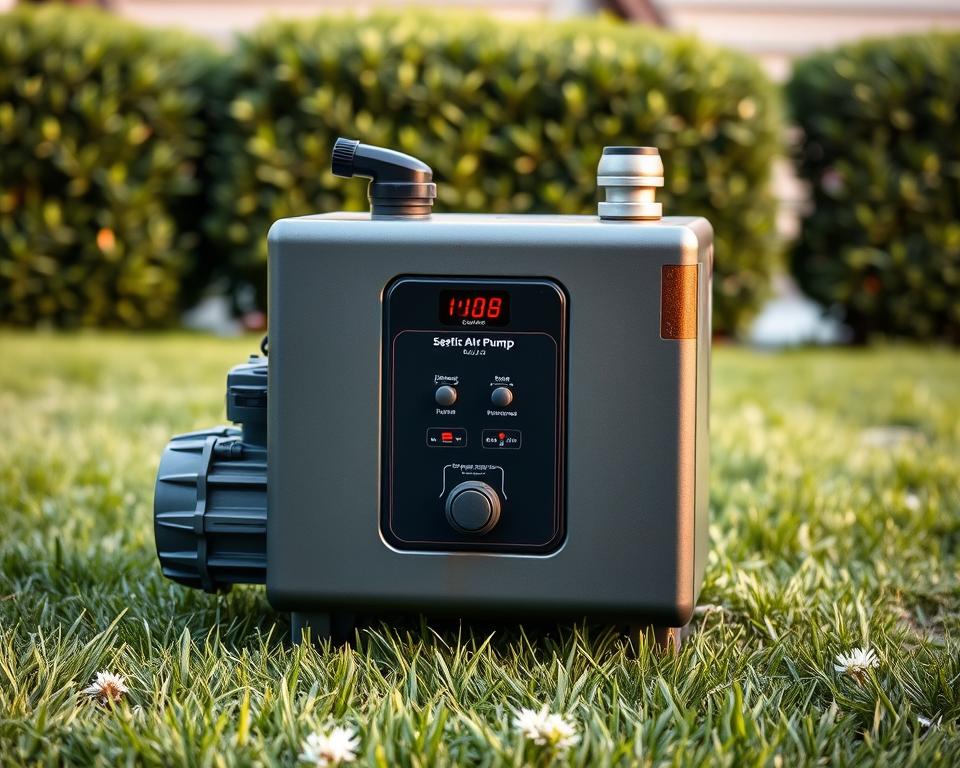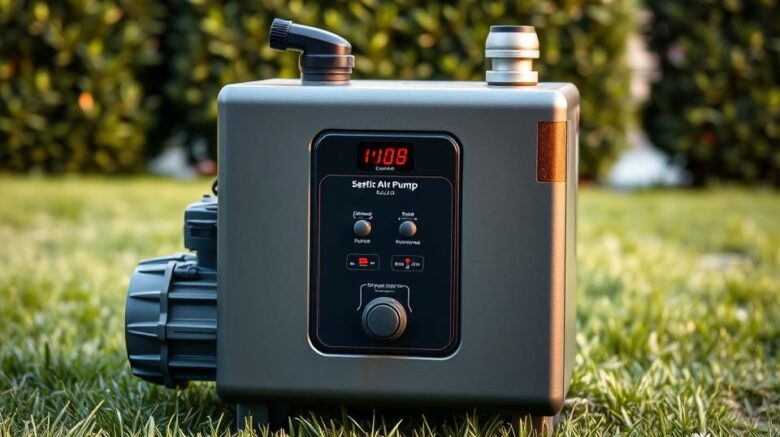Septic Aerator Unit: Complete Guide for Property Owners
Curious about what enhances your oxygen-based Septic system’s effectiveness? The air unit in your Septic system is the unsung key component indispensable for your system. With this resource, readers will get valuable insight on the device’s importance. It’s necessary for a well-functioning, effective Septic system.
Grasping the significance of a Septic tank air Pump can optimize your Septic system’s operation using septic tank pumping services. It also safeguards your real-estate worth and local environment. The resource below will present All in Sanitation, a trusted Septic industry specialist. They’re eager to meet your Septic aerator Pump needs.
Core Messages
- The Septic air Pump is crucial for aerated wastewater units.
- Servicing your Septic system air Pump can enhance overall system performance.
- Scheduled assessments extend the service life of your Septic tank air Pump.
- Choosing the proper Septic aerator Pump is necessary for optimal operation.
- All in Sanitation supplies tailored services for Septic air Pump support.
Getting to Know Aerobic Septic Units
Aerobic Septic systems provide a more effective waste treatment method by using oxygen. This method features aerobic bacteria operating in well-oxygenated environments. These bacteria are more efficient in digesting organic matter. With the help of Septic aerator Pumps, these systems deliver a constant oxygen supply, improving the waste decomposition process.
These systems excel in lowering sludge buildup, because of the efficiency of aerobic bacteria. This reduction in solid waste means less maintenance and tank Pump-outs is required. Additionally, they effectively manage wastewater, producing little to no smell. This produces a improved environment for homeowners and the community as a whole.
To make sure these systems operate smoothly, it’s crucial to grasp the key Septic system components. These include the Septic tank, oxygenation chamber, and effluent Pump. Each element is vital, especially the air Pump. It pushes oxygen into the tank, essential for the aerobic bacteria’s activity.
Importance of the Septic Air Pump
The Septic air Pump is crucial in the operation of aerobic Septic systems. It acts as the system’s “breathing mechanism,” pushing the necessary oxygen needed. This oxygen enables aerobic bacteria to flourish and decompose waste quickly. If the Pump breaks, the system’s efficiency decreases, leading to sludge accumulation and possible odors.
Such issues can disrupt Septic system operations and create environmental hazards. By realizing how essential the Septic air Pump is, homeowners can respond ahead of time. They can ensure its best function through scheduled service. This prevents failures, prevents costly repairs, and maintains the aerobic system’s condition.
Primary Gains of Using a Septic Air Pump
Operating a Septic air Pump notably enhances the capability of Septic systems. Septic air Pumps are crucial as they accelerate the processing of waste. This is accomplished by oxygenating the treatment process, stimulating aerobic bacteria growth. These bacteria are vital for efficient waste treatment.
They’re also important in lowering foul smells. Thanks to more active aerobic processes, waste decomposes faster, thus diminishing odors. This provides a fresher environment for homeowners.
Another noteworthy benefit is the cut in sludge formation. Consequently, tanks require less frequent Pumping, conserving both money and time. Greater processing not only cuts expenses but also prolongs the lifespan of the drain field.
Proper care of these Pumps well means reduced repair costs and adhering to regulatory standards. Thus, the upsides of Septic air Pumps are not only for homeowners. They also enhance environmental health by raising waste management practices.
| Benefit | Description |
|---|---|
| Fast Waste Breakdown | Enhanced aerobic activity hastens the decomposition process. |
| Minimized Odor Emissions | Superior treatment efficacy produces fewer odors. |
| Reduced Sludge Buildup | Less frequent Pumping and maintenance are required. |
| Extended Drain Field Life | Better treatment equals a healthier drain field. |
| Cost Savings | Lower likelihood of repairs and regulatory compliance cost. |

Selecting the Best Septic Air Pump
Choosing the correct Septic air Pump is vital for an optimized aerobic system. Homeowners should assess various factors for the proper choice. The size of the tank and the airflow specifications matter greatly the Pump’s effectiveness.
To make an informed choice, it’s essential to be aware of the air Pumps available. There are mainly two types: diaphragm Pumps and rotary vane Pumps. Each delivers particular pluses, which should be suited with your home’s unique requirements and how it operates.
Energy efficiency also should be considered. Choosing a Pump that cuts energy use while achieving the needed airflow can lead to meaningful reductions. Guidance from All in Sanitation consultants can be extremely useful. They confirm the Pump you choose suits your system’s requirements perfectly.
Typical Classes of Septic Air Pumps
Homeowners can choose intelligently by being aware of the various Septic air Pumps available. There are mainly two types: diaphragm Pumps and rotary vane Pumps. Each has its specific functions and benefits.
Diaphragm Pumps, valued for their silent operation, are commonly used for residential Septic systems. They provide energy efficiency while supplying consistent airflow. Their constant performance is ideal for smaller systems, attracting many homeowners.
Rotary vane Pumps, however, are ideal for bigger or commercial systems. These Pumps produce more power, required when handling bigger loads. Their strong build guarantees efficient operation in extensive Septic systems.
| Type of Pump | Best Use | Advantages |
|---|---|---|
| Diaphragm Pumps | Residential Systems | Quiet operation, energy-efficient, reliable air flow |
| Rotary Vane Pumps | Larger or Commercial Systems | Powerful performance, high capacity, durable construction |
Appreciating the distinctions in Septic air Pumps is essential for upgrades or replacements. Each Pump type delivers specific features to fulfil various needs. This secures optimal performance for any system.
Indicators You Require a Septic Air Pump Replacement
Homeowners must look out for Pump failure signs in their Septic systems. Some signals point towards the need for a Septic air Pump replacement. These help maintain smooth operation. Spotting these quickly stops major issues.
Signs of potential problems include:
- Unusual noises from the Pump, like rattling or shaking, might mean internal damage.
- A clear lack of air output indicates the Pump isn’t functioning properly, impacting efficiency.
- Repeated electrical problems, such as circuit trips or lights dimming, could suggest overloading.
- Visible damage on the Pump unit, with cracks or leaks, requires quick action.
- Foul odors in the yard often signal a compromised Pump, meaning ineffective effluent aeration.
Detecting these signs early stops pricey restoration or total system failure. Performing routine inspections makes it easy to catch these issues. It also shows if you need a new Septic air Pump.
Care Guidelines for Your Septic Air Pump
For an efficient Septic air Pump, consistent service is vital. This ensures that that your system operates correctly. Homeowners can use several straightforward care strategies for best results.
Every six months, run a thorough inspection for wear or damage. It is also essential to swap out the filters as indicated. This stops clogs that could lower efficiency.
The Pump should stand on a solid base to minimize vibrations, which could affect it over time. A protective cover is vital too. It shields against debris and water, keeping the Pump’s functionality.
Regular servicing can considerably prolong the life of your Pump. In turn, this benefits the Septic system’s performance as a whole.
| Maintenance Task | Frequency | Benefits |
|---|---|---|
| Inspect Pump for damage | Every 6 months | Identifies issues early |
| Replace filters | As needed | Maintains airflow |
| Check surface stability | Annually | Minimizes shake |
| Clear debris around Pump | Monthly | Prevents clogs |
Setting Up Your Septic Air Pump
Accurate installation of your Septic air Pump is critical for its optimal operation. At the outset, select a safe, moisture-free area for placement. The chosen spot should securely accommodate the Pump’s weight without strain.
To reliably set up your Pump on your own, observe the following guidelines:
- Gather all necessary items, including the Pump, a power source, and hose fittings.
- Consult the manufacturer’s guidelines before beginning your installation.
- Make sure every connection is secure to eliminate air leaks that compromise performance.
- After assembly, run a test to ensure the system works as intended.
If the installation process appears difficult, get in touch with All in Sanitation. Their professionals can circumvent common errors, guaranteeing your setup complies with mandatory safety requirements.
Why Choose All in Sanitation for Your Septic Air Pump Services
When picking a Septic service provider, the choice is crucial. All in Sanitation separates itself by offering dependable Septic air Pumps. They cater to wide-ranging homeowner requirements with a comprehensive selection of top-tier products. This means customers secure an perfect match for their Septic systems.
What truly separates All in Sanitation is not solely their diverse product lineup. Their dedication to superior customer service is also critical. Homeowners benefit from expert advice, guiding them towards trusted Septic solutions. This partnership is important to customize each solution to satisfy specific needs.
All in Sanitation also emphasizes aftercare to ensure lasting satisfaction. Their devotion reaches beyond the initial sale. They deliver ongoing support to ensure Septic systems running smoothly for the foreseeable future.
Expense Overview for Septic Air Pumps
Grasping the costs associated with Septic air Pumps is important for homeowners who run aerobic Septic systems. Up front, one faces the purchase price, which includes the Pump and required accessories. Installation expenses fluctuate, according to the system’s complexity and any modifications required.
Ongoing upkeep forms an additional cost layer. Regular inspections can ward off bigger issues, in the long run yielding savings. Homeowners should allocate money for Septic maintenance to keep the Pump’s effectiveness and longevity. Such planning helps dodge expensive repairs later on, showing the benefit of proactive maintenance.
| Cost Component | Average Cost Range |
|---|---|
| Septic Air Pump | $500 – $1,200 |
| Installation | $300 – $800 |
| Annual Maintenance | $150 – $400 |
| Potential Repair Costs | $1,000 – $5,000 |
Breaking down Septic air Pump expenses into specific parts supports homeowners in financial preparation. This detailed approach ensures the system’s smooth operation and their reassurance.
To Conclude
For homeowners with aerobic Septic systems, servicing Septic systems is essential. The proper Septic air Pump enhances waste processing and increases your system’s life. Sticking with routine maintenance and swiftly handling issues sidesteps large repair bills and disruptions.
Choosing a Septic air Pump requires careful thought. This guide covered how to select effectively about installation and replacement. With All in Sanitation’s support, you can tackle your Septic systems’ complexities securely.
Taking care of your Septic air Pump enhances your system’s efficiency and service life. It guarantees a trouble-free and proper operation over time. Remember, your home’s wastewater management benefits greatly from regular attention.
